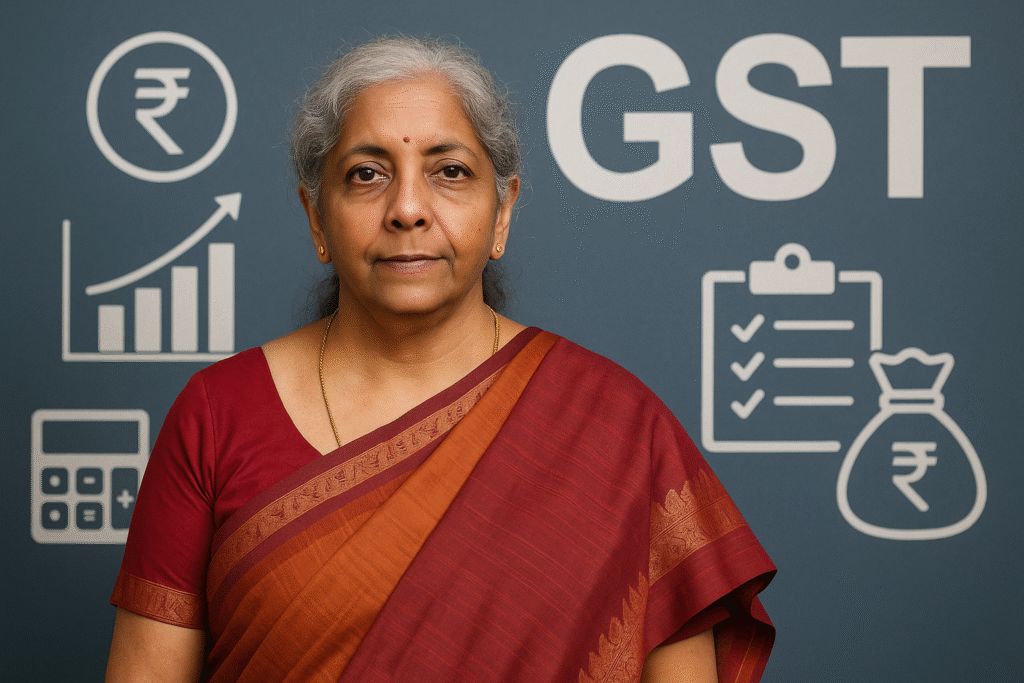The Goods and Services Tax (GST) system in India may soon undergo a significant transformation. According to recent developments, the Finance Ministry is proposing a two-tier GST structure along with special rates on certain goods and services. This proposal, which aims to simplify tax slabs and make the GST framework more efficient, is likely to be discussed in detail at the upcoming GST Council meeting in September.
Why a GST Overhaul Now?

The current GST structure in India has four main tax slabs—5%, 12%, 18%, and 28%—along with some exceptions and zero-rated items. While this multi-slab system was initially designed to balance revenue needs with affordability, it has often been criticised for being complex and prone to disputes.
Over the years, businesses, economists, and policy experts have called for a simpler GST framework to reduce compliance burdens and improve efficiency. The Finance Ministry’s two-tier structure proposal is seen as a response to these concerns, aimed at making GST easier to understand and implement for businesses and consumers alike.
Proposed Two-Tier GST Structure: An Overview
While the final details will be confirmed only after the GST Council meeting, sources suggest that the new GST regime may include two broad slabs—one lower rate and one standard rate—alongside a higher “special” rate for luxury and sin goods.
- Lower Rate Slab – Likely to cover essential goods and basic services, ensuring affordability for the general public.
- Standard Rate Slab – Expected to apply to most goods and services, replacing the current multiple mid-tier rates.
- Special Rate Category – Applicable on select luxury items, high-end services, and products considered “sin goods” such as tobacco, alcohol, and high-end cars.
This move would reduce the number of GST slabs from four to two (plus special rates), thereby streamlining tax administration.
Impact on Businesses
For businesses, a two-tier GST system could bring multiple benefits:
- Simplified Compliance – Fewer slabs mean fewer classification disputes and easier tax calculations.
- Reduced Litigation – Many current GST-related disputes arise from disagreements over applicable tax slabs. A simplified structure would likely reduce such conflicts.
- Cost Savings – Simplified filing processes and reduced ambiguity could lower operational costs for businesses.
Small and medium-sized enterprises (SMEs), in particular, stand to benefit as they often lack the resources to navigate complex tax structures.
Impact on Consumers

From a consumer perspective, the two-tier system could lead to:
- Price Stability – With fewer slab changes and clearer classification, consumers may experience more stable pricing for goods and services.
- Greater Transparency – Understanding GST rates will become easier for the public, allowing for more informed purchasing decisions.
- Potential Price Adjustments – Some items may see price reductions if moved to a lower slab, while others could become more expensive if shifted to the higher slab.
Special Rates for Select Items
One key part of the Finance Ministry’s proposal is the introduction of special rates for certain goods and services.
These would include:
- Luxury Goods – High-end electronics, designer clothing, premium cars, and luxury watches.
- Sin Goods – Tobacco, alcohol, and other products considered harmful to health.
- Environmentally Harmful Goods – Products with a high carbon footprint or those contributing significantly to pollution.
The aim is to tax these goods at higher rates while keeping essential items affordable, in line with principles of equity and public welfare.
Economic Rationale Behind the Proposal
The Finance Ministry’s proposal is driven by both economic efficiency and revenue needs:
- Simplification Boosts Compliance – Studies have shown that simpler tax structures increase voluntary compliance, leading to higher revenue collection.
- Higher Revenue from Special Rates – Taxing luxury and sin goods at higher rates can offset revenue losses from lowering rates on essentials.
- Boosting Consumer Demand – Lower GST rates on essentials could leave consumers with more disposable income, potentially increasing spending in other areas.
Challenges and Concerns
While the proposal is being welcomed by many, it is not without challenges:
- Revenue Neutrality – The government must ensure that the new structure maintains or improves current revenue levels.
- State Concerns – Since GST is a shared revenue between the Centre and states, any changes in rates could spark disagreements over revenue distribution.
- Transition Issues – Businesses will need time and resources to adjust accounting systems and pricing strategies to the new structure.
- Classification of Goods – Determining which products fall under essential, standard, or special categories could still lead to debates.
Global Comparisons
Globally, many countries operate with two or three GST/VAT rates, often with a higher rate for luxury or non-essential goods. For example:
- Australia – Single GST rate of 10% on most goods and services.
- Canada – GST at 5% with some provincial variations.
- United Kingdom – Standard VAT of 20%, with reduced and zero rates for certain goods and services.
India’s shift toward a two-tier system would align it more closely with international practices while retaining a degree of flexibility through the special rate category.
The September GST Council Meeting: What to Expect
The GST Council meeting scheduled for September will be a crucial event. Key points likely to be discussed include:
- Finalisation of the lower and standard GST rates.
- Defining goods and services for each slab.
- Deciding which items will attract special rates.
- Transition timelines and implementation strategies.
The Council will also need to assess the revenue implications and work towards consensus among states to ensure smooth adoption.
Potential Timeline for Implementation
If approved in the September meeting, the new GST structure could be implemented in phases:
- Phase 1 – Announcement and notification of new rates, giving businesses a transition period.
- Phase 2 – Gradual migration to the new slabs, starting with essentials and standard goods.
- Phase 3 – Introduction of special rates for luxury and sin goods.
The entire transition may take six months to a year to ensure minimal disruption.
Conclusion
The Finance Ministry’s proposal for a two-tier GST structure with special rates represents one of the most ambitious reforms to India’s indirect tax system since the introduction of GST in 2017. By simplifying slabs, reducing disputes, and ensuring higher taxes on luxury and harmful goods, the move could strike a balance between ease of doing business and revenue needs.
All eyes are now on the September GST Council meeting, which will decide the future shape of India’s tax system. If implemented effectively, this overhaul could pave the way for a simpler, fairer, and more transparent GST regime that benefits both businesses and consumers.
➡️ Stay tuned to IndianCurrentAffairs.com for real-time updates,

